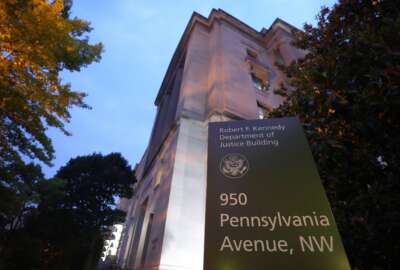
A crisis is blooming in the US immigration courts
Immigration courts have become what my next guest calls the dumping ground for the nation's systemic immigration failures. And that's caused enormous backlogs on...
Immigration courts have become what my next guest calls the dumping ground for the nation’s systemic immigration failures. And that’s caused enormous backlogs on the immigration court dockets. For more the Federal Drive with Tom Temin turned to senior research associate at the University of Notre Dame, Don Kerwin.
Interview Transcript:
Tom Temin Well, let’s begin with the current situation in the immigration courts. Backlogs growing, getting longer. What is going on there?
Don Kerwin Yeah, the backlogs have reached untenable numbers. They’re approaching 2 million with no end in sight.
Tom Temin And there are a limited number of immigration judges. It’s only like 1500 or 1600, if I recall, correct?
Don Kerwin No, actually, it’s less than that. It’s it’s around 700. So it’s the idea that with this current number, you could possibly make meaningful progress in reversing the backlog and ultimately eliminating it is fanciful.
Tom Temin Yes. And we should note that immigration courts are part of the Department of Justice, and so they are firmly in the executive branch. And what’s your sense of whether the Justice Department is paying attention to this, is seeking more appropriations or otherwise dealing with it?
Don Kerwin I think that the Justice Department is paying attention to it. It may not be a high priority for the Justice Department, but it certainly is for the arm of the Justice Department that runs the immigration court system, which is the Executive Office for Immigration Review. But the appropriations are asking for additional judges, legal staff and monies for EOIR. And that’s been growing a bit, but not nearly fast enough.
Tom Temin Right. And is this desirable work for someone to be an immigration judge? Because the ones I’ve spoken to over the years are quite proud of the work that they do. But it seems like you’d need exponentially more of them, like 7000, to deal with millions of backlog.
Don Kerwin I think we’ve run some numbers and under various scenarios in terms of case receipts and case completions. And it looks like the number needs to be at least tripled for them to make meaningful progress on the backlog. The problem is really that there’s so many cases coming into the system and they’re not being screened. Even cases that may never result in removal or where the case may be adjudicated. And before the U.S. Citizenship and Immigration Services, because there is pending application for benefit, there needs to be an increase in judges and lots of other reforms. But yeah, I mean, I think in terms of the judges themselves, the stakes are, of course, very high. Many cases involve life or death decisions, literally separation of families, whether people will lose their homes and their livelihoods. I mean, it’s very, very consequential and high pressure work. There have been normal higher than normal attrition rates in recent years. And I think that there’s a real tension for many judges between operating independently and doing justice before the case before them in the face of expectations that they need to complete a lot of cases, whether it’s 500 a year or 700 a year as it was under the Trump administration. And so it’s a difficult job. And traditionally, there hasn’t been sufficient support for the judges in terms of legal staff, clerks and legal assistance and the like, although that seems to be improving. And I mean, I can talk a little bit, but I think another major tension is that they just don’t have the kind of authorities that other judges have. Immigration system is a very strange system. It’s exceptional in a lot of ways that aren’t helpful.
Tom Temin And before we get to some of those details, just maybe review for us briefly what precisely immigration judges make judgment on.
Don Kerwin Immigration judges adjudicate removal proceedings, whether non-citizens are removable or whether there is some relief that’s available to them, whether that’s political asylum or an equitable form of relief called the cancellation of removal. Or that some can adjust to permanent residence now. And so are they removable and do they have relief from removal? They’re situated within the Executive Office for Immigration Review. There’s a separate court of appeals on immigration cases called the Board of Immigration Appeals. And they have other functions like they review applications of charitable organizations whose not attorneys would become accredited to represent people on immigration matters and administrative matters. That’s a major function that they have. They also have very extensive legal orientation and assistance programs for people that come before them. So it’s a lot of work that they do, an important work.
Tom Temin We are speaking with Don Kerwin. He’s senior research associate at the University of Notre Dame. He’s also former executive director of the Center for Migration Studies. And I wanted to ask you then, the judges dealing with people, the people they deal with have come in legally or illegally. What does all that mean?
Don Kerwin It means they’re in removal proceedings. Some of them would have entered the country illegally, but some may have presented themselves at a border to an immigration official. And that would be the more common thing these days. But they’re facing removal nonetheless. And even populations like the large numbers that have been paroled for humanitarian reasons into the country in recent years, those are people that have legal status, but it’s not going to lead to permanent status and it’s for a fixed period of time. So they may find themselves in removal proceedings as well.
Tom Temin And as a practical matter, if someone is ordered to be removed and that has to be decided by a judge and the judge has a endless backlog, that means that person could be resident in the United States in some status or another for years. Correct.
Don Kerwin Not necessarily kind of a resident status, but they are in removal proceedings. So they’re going through that process. Some of them may have some status, others, but most of them will not have that. Other than that they’re seeking, say, political asylum or or seeking some kind of relief in the context of removal proceedings.
Tom Temin But physically, they’re in the country.
Don Kerwin Yeah, right. They’re all in in the United States. That’s correct.
Tom Temin And what can they do then? Employers aren’t allowed to hire them, Correct. And so is that part of what you’re calling the broken immigration system that’s dumping onto the courts?
Don Kerwin I mean, if you’re undocumented, right, you’re not able to work legally. So I think the broken immigration system is more the fact that who we see in the backlog are people that are the result of other problems in the immigration system. For example, there’s 4 million people that have been approved for visas tentatively. In other words, they might have the relationship to a U.S. citizen or a lawful permanent resident that would qualify them tentatively for a visa. So that relationship exists, and yet they’re stuck in these multi-year backlogs pending on the category that they’re in these back. And the country that they’re from, the backlogs can run 20 years. So you see some of those people, in fact fairly significant numbers of them, in the court backlogs as well. If you fix the visa backlog, you would help contribute to fixing the court backlog. And there’s a number of situations like that.
Tom Temin Yeah. So Justice Department can do what it can do to get more judges and staff and so forth. It sounds like upstream you need homeland security perhaps to do something differently. But ultimately, it sounds like you need Congress to do something differently. Let’s start with DHS.
Don Kerwin Yeah, I mean, I think that the judges have no say. EOIR has no say in who comes into their system. EOIR’s budget I think last year was $760 million. And you compare that to the appropriated monies for the two enforcement agencies at DHS, which is about $26 billion. So you have a system that’s enormous and an enforcement system. It’s feeding these cases into a very small adjudication system, and there’s a real disconnect there. So that’s another one of those systemic problems. And I think the large systemic problem, too, is the politicization of immigration and the fact that we really haven’t had meaningful immigration reform for decades now. And as a result of that, those problems are seen in the immigration courts as well. Long term, undocumented people that have strong, equitable ties in the United States but haven’t been legalized, that population is almost, almost a permanent population at this point, given that we haven’t had a general legalization bill since 1986. So there’s all these problems that generally the immigration courts are blamed for this situation, and that’s extraordinarily unfair because really what it is, is dumping ground is a rough way to say it, but it’s an accurate way to say it. The court backlog is a function of all of the systemic problems and structural problems that haven’t been fixed decades in the U.S. immigration system.
Tom Temin And just briefly, a fixed immigration system would do what then do you feel?
Don Kerwin The components of it would be to rethink the legal immigration system, which is the most important part of it, that it’s not aligned with labor needs. It’s not it’s not aligned with the needs of the country at this point. So that’s the key part of it. And then there ought to be a legalization program, a large legalization program for a population that’s been here for a long, long periods of time and have built strong, equitable ties, family ties, work ties, community ties over that period. So, I mean, those are two of the major issues. And then things like the visa backlog problems, those can be easily remedied. And there’s several proposals to do that, including just using visas that go unused and that would reduce the visa backlog rather dramatically. So there’s fixes for all of these problems that manifest themselves in the court backlog that Congress just has enacted.
Copyright © 2025 Federal News Network. All rights reserved. This website is not intended for users located within the European Economic Area.
Tom Temin is host of the Federal Drive and has been providing insight on federal technology and management issues for more than 30 years.
Follow @tteminWFED






